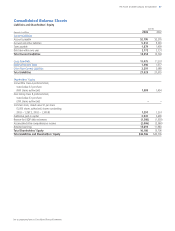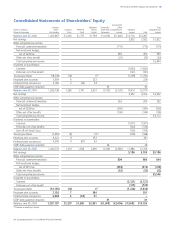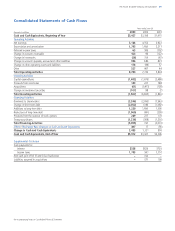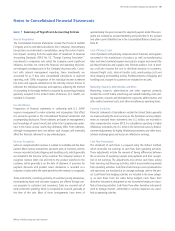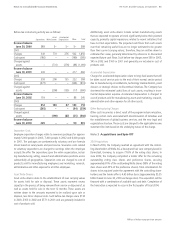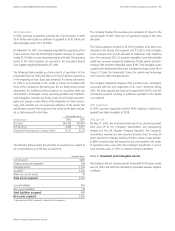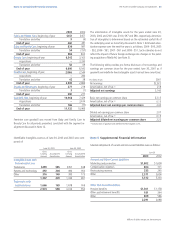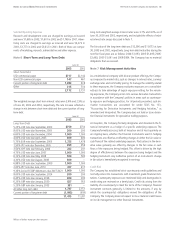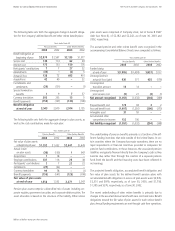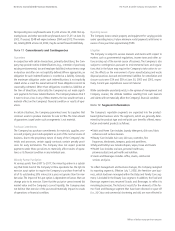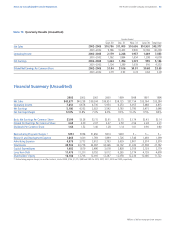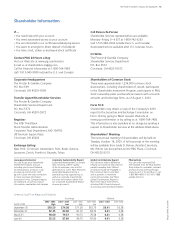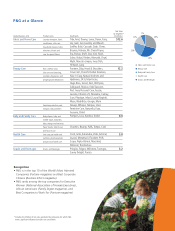Proctor and Gamble 2003 Annual Report Download - page 49
Download and view the complete annual report
Please find page 49 of the 2003 Proctor and Gamble annual report below. You can navigate through the pages in the report by either clicking on the pages listed below, or by using the keyword search tool below to find specific information within the annual report.Notes to Consolidated Financial Statements 47The Procter & Gamble Company and Subsidiaries
sets and $26 and $25 in liabilities, respectively. The gain or loss on
these instruments is immediately recognized in earnings. The net impact
included in marketing, research, administrative and other expense was
$264, $50 and $38 of gains in 2003, 2002 and 2001, respectively,
which substantially offset foreign currency transaction losses of the
items being hedged.
Net Investment Hedging
The Company hedges its net investment position in major currencies
and generates foreign currency interest payments that offset other
transactional exposures in these currencies. To accomplish this, the
Company borrows directly in foreign currency and designates a portion
of foreign currency debt as a hedge of net investments in foreign sub-
sidiaries. In addition, certain foreign currency swaps are designated as
hedges of the Company’s related foreign net investments. Under SFAS
No. 133, changes in the fair value of these instruments are immediately
recognized in OCI, to offset the change in the value of the net invest-
ment being hedged. Currency effects of these hedges reflected in OCI
were a $418 and $397 after-tax loss in 2003 and 2002, respectively.
Accumulated net balances were a $238 after-tax loss in 2003 and a
$180 after-tax gain in 2002.
Commodity Price Management
Raw materials used by the Company are subject to price volatility
caused by weather, supply conditions, political and economic variables
and other unpredictable factors. To manage the volatility related to cer-
tain anticipated inventory purchases, the Company uses futures and op-
tions with maturities generally less than one year and swap contracts
with maturities up to five years. These market instruments are designat-
ed as cash flow hedges under SFAS No. 133. Accordingly, the mark-to-
market gain or loss on qualifying hedges is reported in OCI and reclas-
sified into cost of products sold in the same period or periods during
which the hedged transaction affects earnings. Qualifying cash flow
hedges currently recorded in OCI are not considered material. The mark-
to-market gain or loss on non-qualifying, excluded and ineffective por-
tions of hedges is immediately recognized in cost of products sold.
Commodity hedging activity was not material to the Company’s finan-
cial statements for the years ended June 30, 2003, 2002 and 2001.
Note 8 Earnings per Share and Stock Options
Net Earnings Per Common Share
Net earnings less preferred dividends (net of related tax benefits) are
divided by the weighted average number of common shares outstand-
ing during the year to calculate basic net earnings per common share.
Diluted net earnings per common share are calculated to give effect to
stock options and convertible preferred stock (see Note 9).
Interest Rate Management
The Company’s policy is to manage interest cost using a mix of fixed-
rate and variable-rate debt. To manage this risk in a cost efficient man-
ner, the Company enters into interest rate swaps in which the Company
agrees to exchange, at specified intervals, the difference between fixed
and variable interest amounts calculated by reference to an agreed-
upon notional principal amount.
Interest rate swaps that meet specific conditions under SFAS No. 133
are accounted for as fair value hedges. Accordingly, the changes in the
fair value of these agreements are immediately recorded in earnings.
The mark-to-market values of both the fair value hedging instruments
and the underlying debt obligations are recorded as equal and offset-
ting gains and losses in the interest expense component of the income
statement. The fair value of the Company’s interest rate swap agree-
ments was $322 at June 30, 2003 and $231 at June 30, 2002. All ex-
isting fair value hedges are 100% effective. As a result, there is no
impact to earnings due to hedge ineffectiveness.
Foreign Currency Management
The Company manufactures and sells its products in a number of coun-
tries throughout the world and, as a result, is exposed to movements in
foreign currency exchange rates. The purpose of the Company’s foreign
currency hedging program is to reduce the risk caused by short-term
changes in exchange rates.
The Company primarily utilizes forward exchange contracts and pur-
chased options with maturities of less than 18 months and currency
swaps with maturities up to five years. These instruments are intended
to offset the effect of exchange rate fluctuations on forecasted sales, in-
ventory purchases, intercompany royalties and intercompany loans de-
nominated in foreign currencies. The fair value of these instruments at
June 30, 2003 and June 30, 2002 was $27 and $60 in assets and $92
and $29 in liabilities, respectively. The effective portion of the changes
in fair value for these instruments, which have been designated as cash
flow hedges, are reported in OCI and reclassified in earnings in the
same financial statement line item and in the same period or periods
during which the hedged transactions affect earnings. The ineffective
portion, which is not material for any year presented, is immediately
recognized in earnings.
The Company also utilizes the same instruments for purposes that do
not meet the requirements for hedge accounting treatment. In these
cases, the change in value of the instruments offsets the foreign curren-
cy impact of intercompany financing transactions, income from interna-
tional operations and other balance sheet revaluations. The fair value of
these instruments at June 30, 2003 and 2002 was $113 and $93 in as-
Millions of dollars except per share amounts


